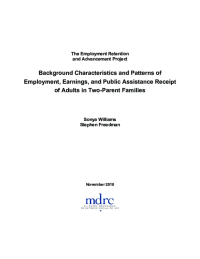Background Characteristics and Patterns of Employment, Earnings, and Public Assistance Receipt of Adults in Two-Parent Families
The national Employment Retention and Advancement (ERA) project tested the effectiveness of over a dozen innovative programs in eight states that were intended to promote steady work and earnings growth among current and former welfare recipients — that is, recipients of Temporary Assistance for Needy Families (TANF) — and other low-wage workers. The programs offered services primarily to single parents, but nine programs also offered services to adult members of two-parent families.
This report describes the background characteristics, employment and earnings patterns, and patterns of TANF and food stamp receipt for adult members of two-parent families in the ERA sample. Not much is known about the low-income two-parent population’s need for employment retention and advancement services or about their responses to offered services. This population has particular policy relevance in that two-parent TANF cases include more family members and receive higher average monthly grants than do single-parent recipients. These families therefore require higher income (from employment of one or both parents) to achieve self-sufficiency.
Key Findings
- In the ERA sample, retention and advancement is as important an issue for low-income two-parent family members as for single parents. Most two-parent and single-parent sample members worked during the follow-up period, but only slightly more than half in each group were continuously employed for four or more quarters. This employment stability, in turn, is associated with other positive economic outcomes in both samples, including much higher average annual earnings and earnings progression during the follow-up period. Rates of TANF receipt declined steadily for both two-parent and single-parent sample members after study entry, but many members (and similar proportions) of both samples continued to receive food stamps during Year 3.
- Men and women in two-parent families were equally likely to work during the follow-up period, but men earned more, on average. Most men and women in two-parent families worked during the follow-up period, and a similar proportion of men and women experienced employment stability. Among two-parent sample members with stable employment, men had much higher annual earnings, but earnings were similar for men and women who never experienced stable employment.
The results suggest that adults in low-income single-parent and two-parent families have a roughly equivalent need for services to support employment retention and advancement and that this need does not differ substantially between men and women in two-parent families.






